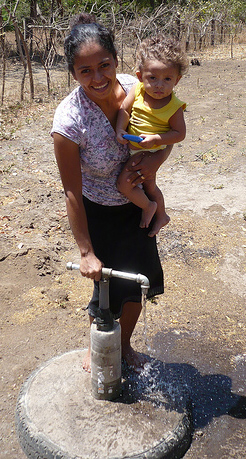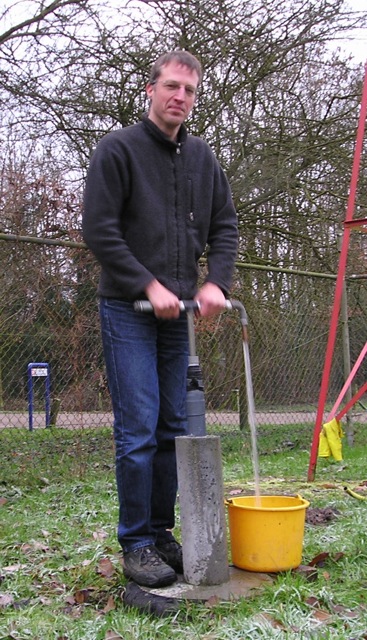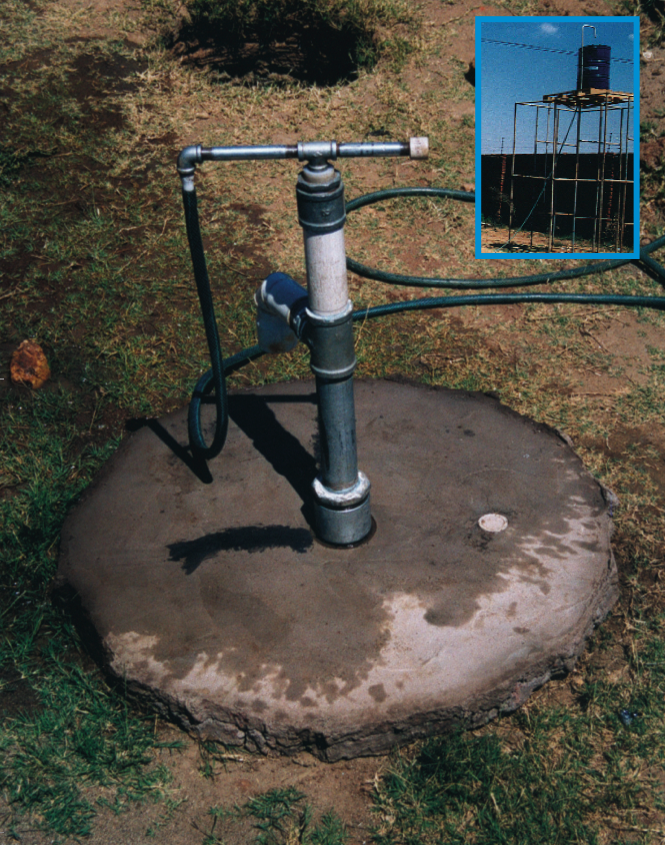EMAS pump


The EMAS pump (also called the EMAS Flexi pump) is a very cheap PVC piston pump for family use, which can both pump water from a well and pump it to an elevated point. For example, it can pump water from 20 meters underground directly to an elevated tank another 20 meters above the ground level. The ability to pump directly to a storage tank avoids handling of the water, which avoids contamination.
The EMAS pump compresses water between two one-way valves (check valves produced with glass marbles), a footvalve and a piston valve. Water is forced up the piston tube and comes out of the pump handle.
In many rural areas, people collect water used for domestic purposes from a central water source. These can be very far away from home, therefore collecting water takes up much time and energy on a daily basis. It is much more convenient to at least connect a distant pump to a local faucet for water in the kitchen, and if possible also for a shower. It also encourages better personal and domestic hygiene. This is possible using the EMAS pump, since it ejects water with the necessary pressure to transport it from its source up to an elevated distribution tank.
The EMAS school
EMAS is the acronym for Escuela Móvil de Agua y Saneamiento (Mobile School for Water and Sanitation), in Bolivia, whose director, Wolfgang Eloy Buchner, developed the EMAS pump in the 1990's.
EMAS is not only the name of the mobile school for water and sanitation, but also a whole technical and social concept of water and sanitation which includes rain water harvesting, solar water heaters, windpower, hydraulic rams, water treatment, small tanks and sinks, a variety of hand and foot pumps, and ferrocement tanks. The aim of the technologies and systems is to achieve the necessary supply of drinkable water, and water for micro irrigation in rural and sub urban areas.
Suitable Conditions
The EMAS pump is designed for household water supply at family level. Large diameter models can be used for small scale irrigation if the water is very superficial.
Several variants of the EMAS pump exist, such as adaptations to shallow wells (larger diameter, higher output), very high pressure (up to 60 m head) and foot-operated balancing devices. It can be coupled to windmills, children's seesaws, animal roundabouts etc. An EMAS pump can fit in boreholes as narrow as 1.25", which means that cheap, hand drilled boreholes are possible, such as with the Jetting - EMAS method.
EMAS pumps can be used to pump to a depth of 40-50 m. Deeper than 40-50 m, the pumping becomes very heavy. The EMAS pump can pump up to 30 l/min from a depth of 10 m, when operated by hand. Total production is up to about 5 m4/day. (That is: 5 m3 from 1 m depth or 0.5 m3 from 10 m or 250 l/day from 20 m depth etc.).
Lifespan
The lifespan of an EMAS pump can be estimated as 2 million liters pumped. PVC pumps are not as sturdy as metal ones. Ideally, they should serve a single family who owns and maintains it. Communal use is possible if maintenance and repair are well organized, but a single pump is not recommended to serve more than 100 people.
| Advantages | Disadvantages |
|---|---|
| - Comfort of having water supply in the house - Can pump directly into an elevated storage tank, avoiding water handling in buckets |
- Less resistant to very intensive use and mistreatment than metal pumps. - Output is on down-stroke. That makes it slightly more complicated to fit a lever or treadle. |
Construction, operations and maintenance
The EMAS pump and ferrocement tank need to be operated correctly.
Rural people are easily taught to build their own, using two (glass) marbles, simple PVC pipes, thread adapters and (galvanized) iron pipe, available in any hardware store. The pump uses a gasket that is made from the nylon-reinforced sidewall of used tires, which is widely available and already used in most rural areas for other purposes. Having built their own pump, people are able to maintain it forever. Only basic hand tools required.
Using a ferrocement tank and pipes, it is possible to install a shower and additional tap for laundry or kitchen usage. The tank is arranged on 4 solid wooden supporting beams at a height of about 2m. The distance between the beams should not exceed 80 cm. The shower can be installed under the tank by setting a plastic sheet around the beams to be used as a screen when taking a shower.
Further, a laundry or kitchen basin is set up 80 cm high, and the faucet 1 meter high. The drain pipe is required with a diameter from 3/4" to 1 1/2". It has been observed that a 3/4" polyethylene hose is sufficient, and also very inexpensive. For the pipes to the faucet it is advisable to use PVC 1/2" pipes, with folding or coiled accessories. Accessories manufactured by hand will also be useful, since there is not much pressure in this system.
Maintenance
The piston gasket (made from the nylon-reinforced section of a used tire) can wear slowly over time and and must occasionally be replaced. This can be done easily and in less than an hour by a user that understands the simple operation of the pump. If the pump is constructed properly, there will be a range in which the gasket can be adjusted to achieve the proper balance between ease of pumping and hydraulic efficiency between replacements.
Costs
The EMAS pump costs about US$ 5 (mainly the metal handle), with 1 US$ extra for each meter depth. (prices from Nicaragua, 2006).
Cost of introduction (project cost with knowledge transfer, hands on training, plus 20 pumps):
- Training: 1 day (depending on level of participants)
- Materials for 20 pumps: US$ 100.
- Tools: US$ 50 - 200 if everything has to be bought new.
Field Experiences
Some 20,000 EMAS pumps are in use in Bolivia and some 10,000 in Brazil. It is used in Peru, Equador and Nicaragua. Successfully introduced in South-East Asia (a.o. post-tsunami Sri Lanka) and several African countries.
Successful introduction is variable however, depending on capacity and motivation of early adopters. If people built their pump themselves, they are usually kept in good working condition for years.
Manuals, videos and links
Videos
EMAS water system |
technologies |
all EMAS Pump types |
- Step-by-step 10 short videos: Build an EMAS Pump. By Simple Water Technology.
- Many of the EMAS technologies can be seen on The EMAS Vimeo Channel
Other resources
- Illustrated EMAS pump construction manual, by Paul Cloesen
- A similar design published by ECHO
- WATER FOR EVERYBODY: A Selection of Appropriate Technologies to be used for Drinkable Water EMAS. Wolfgang Buchner, 5th edition, 2006.
- The Technology Demonstration Center EMAS works with EMAS pumps. See Akvopedia article on Technology Demonstration Centers.
- EMAS website in English
- Low-cost pump alternatives for rural communities in Honduras (rope- and EMAS pumps), SKAT website
- Comité Sí a la Vida (Nicaragua, in Spanish)
- Akvo solution of the week 7
Acknowledgements
- Building an EMAS Pump. or (alternative link). Paul Cloesen, December 2007.


